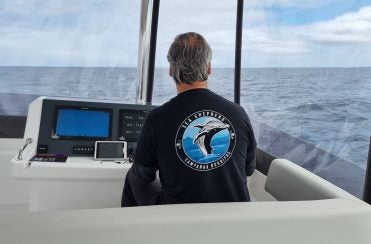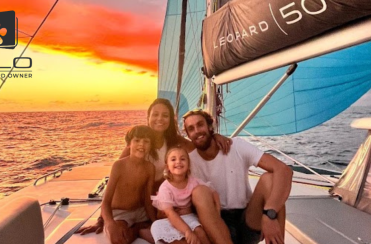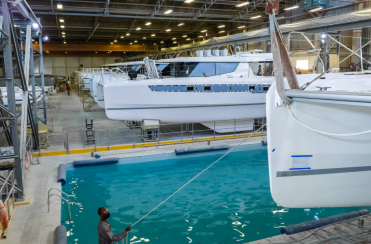You’ve got a lot of choices when it comes time to choose a catamaran, and across those choices, you’ll find a broad range of options for comfort, amenities, sailing features and performance, and quality. Narrowing it down to one brand or model takes some work since there’s no one-size-fits-all boat. To make a good choice, you also need to know yourself and what you want.
Our top five considerations for choosing a catamaran are:
- Living Space & Accommodations
- Sailing Comfort
- Ease of Handling
- Build Quality
- Designed Purpose
Living Space & Accommodations
How many people will you sail with regularly? What’s your plan for cooking and entertaining in remote places versus exploring the nightlife and restaurants in busy ports? A full-time cruising family with young kids will have very different needs from a couple purchasing a boat in a charter fleet for personal use one month out of the year.
Most catamarans are available in multiple configurations, with options for the number and layout of cabins and bathrooms and other options for utility and laundry rooms or extra sleeping space. Most “Owner” versions have a larger master stateroom and may have one cabin converted for utility, while other versions targeted for the charter market will maximize cabins and head space to sleep more on board.
You’ll spend a lot of time in the saloon and galley space, which usually connects to the aft cockpit in one continuous open plan at anchor. Pay close attention to the galley layout if you’ll be away from restaurants in more remote places, and think about how you and your crew and guests will make use of the common areas when you’re not sailing. Leopard’s innovative, forward cockpit takes this spacious layout one step further to extend the living space.

Sailing Comfort and Performance
Catamarans are inherently comfortable sailing boats. Because they don’t heel hard like monohulls, heading upwind will always be easier on the crew. But multi-hull design choices can also affect crew comfort, especially for offshore sailing.
Cruising cats like Leopards are designed to balance comfort and sailing performance. You’ll find their motion at sea easy, and they’ll still get up and get some breeze without making you grab four handholds.
Look closely at the helm station for your first comfort check. Someone will spend a lot of time up there, so seating should be comfortable, with easy access and good handholds for moving around quickly when necessary. A raised flying bridge helm station gives great protection from the elements and unparalleled visibility while still keeping the helm in touch with the crew in the connected cockpit.
Other comfort checks are more big picture; you’re looking for sea-kindly motion and a boat that doesn’t pound into waves and chop. These are design and build issues, so you’ll need to look at factors like the hull form and the bridge deck height to ensure maximum comfort.
Unfortunately, these things aren’t so easy for a layman to assess, as they involve technical knowledge of topics like hull volume, bow design, windage, and bridge deck height. What boat buyers can do is research different vessels and learn a little about how various design factors will impact performance, comfort and safety.
Boat buying can be an emotional process where you decide with your heart as much as your head. But for something as important as sailing comfort, it pays to engage your brain in some research and analytical study.
Ease of handling
You can make any sailboat easier to handle, but a good catamaran is designed for ease of use. It will have a layout with excellent tools for sailing and boat handling from the get-go. The setup isn’t just suitable instruments, furling, and sail controls but also where they install those controls and how easily you can reach them. In the best case, you can ease trim and set your sails from the helm station or near it, so you and your crew aren’t running all over the boat every time conditions change.
Beamy catamarans can be tricky to move in close quarters, and a high helm seat with good visibility is a powerful tool for pain-free docking. When you walk onto a new boat, sit at the helm and look at how well you can see the bows and sterns. While you can’t see everywhere on larger cats, there should be clear lines of sight and places to install cameras and other tools to help with close-in maneuvering.
Check out Leopard’s raised helm station design for an example of good visibility and handy layout for sail and boat controls.
Build Quality
Catamaran construction is technically challenging and more complicated than monohull construction because of the complexity of joining two hulls and building a solid bridge deck. Builders and designers have many techniques and materials to choose from to build a boat. Two boats which look similar from a distance can be starkly different when you inspect how they’re put together.
Workmanship and technique make the difference between a poorly built boat and a safe, seaworthy vessel. Materials are less important than skilled builders, so look for a boat built by a yard that has a track record of building quality boats from quality materials. You don’t need to pay top dollar for space-age materials to get a safe, well-found boat.
When looking at a boat, look inside lockers and cabinets and under floorboards if you can. These out-of-the-way areas tell that a boat is well built. A good boat will have a quality finish even where you can’t see it. And woodwork and joinery will have a neat, aligned fit without gaps, spaces, or crooked joints, even in the back of the cabinets.
The other thing to check out about the build is the ease of access to maintain systems. A good design gives easy access to critical boat systems like engines and refrigeration. Whether you’re fixing your boat yourself someplace remote or paying a technician hourly, you don’t want access to be difficult and time-consuming. Leopard takes many lessons about ease of access and maintenance from their partnerships with the charter industry.
Designed Purpose
The designed purpose is the most important consideration of all because it connects all the factors we’ve discussed. Manufacturers build every boat to a design brief that speaks to what is most important in the finished yacht. Will the owner race the boat? Or will they sail it coastally, cruise full-time, or put it in a charter fleet?
The answer to those questions dictates every design choice and step in the build process. Boats built for speed will use more expensive materials and build techniques to save weight. Racers will have narrower hull forms and less interior volume than boats made for cruising comfort. You can race or cruise any boat, but if you’re looking for comfortable cruising, you may find a lighter racing catamaran more work to sail, less comfortable offshore, and limited in how much gear you can bring compared to a cruising catamaran like a Leopard.
In an ideal world, you’ll find a boat that meets your purpose. If you start out with a clear idea of how you are most likely to use the boat, you’ve got a much better chance of finding the right boat for you.





